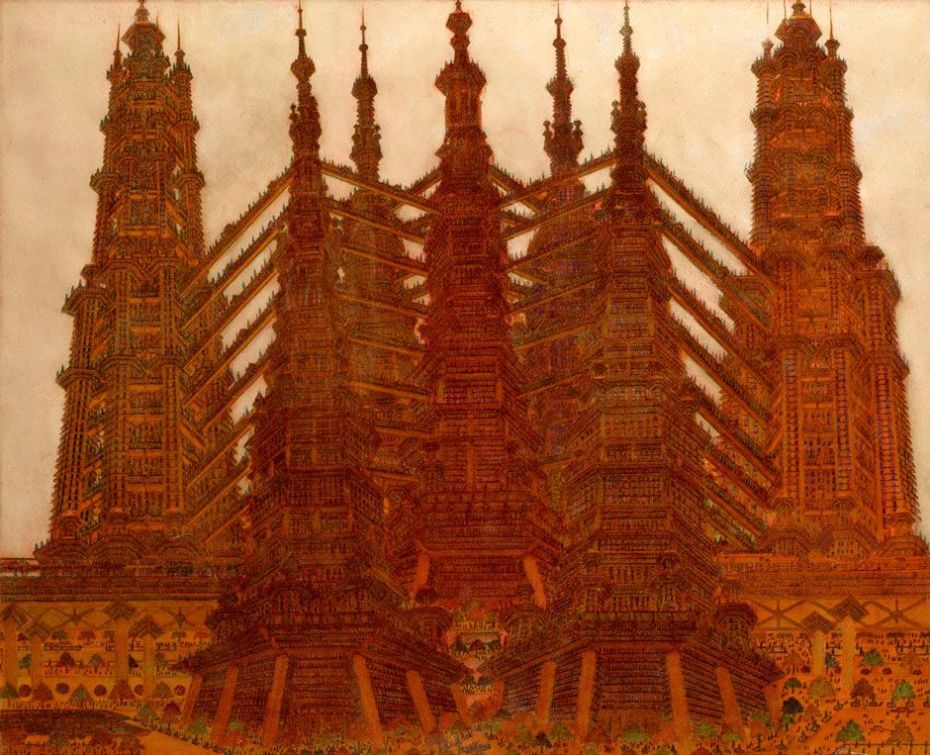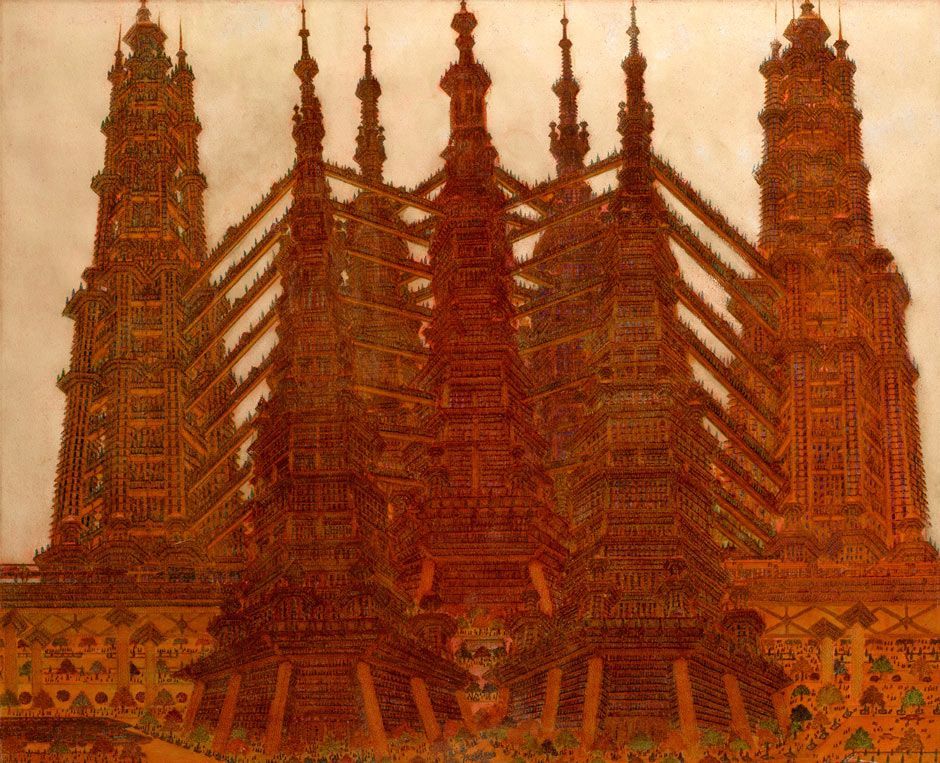I DON’T CARE ABOUT CONTEMPORARY ART ANYMORE?
| October 7, 2014
Some might have thought that the end of painting as an artform arrived with Malevich’s reductionist abstractions about 100 years ago. How could anyone do less than paint a square or circle? (He didn’t reckon with future artists who would merely describe a proposal for a painting in words.) Well, those abstractions didn’t kill it off, as even he went back to painting eventually. There is a wonderful show at the Tate Modern here in London of his work—more on that in another post. But now I’m wondering if economics might kill painting off this time, along with a number of other kinds of work that we sometimes think of as part of our culture.
I live near the galleries in Chelsea, on the west side of Manhattan. When I moved there not too long ago, the galleries were already in place—having edged out a lot of auto body repair shops and the like. Now it is quickly being transformed into a zone of luxury condos. I live in a nice condo, truth be told, but it’s not as new or fancy as many of the others that are going up—but it’s pretty nice. I could, unfortunately, be considered part of that “condoization” trend.
I used to take my lunch breaks browsing the galleries—I could see a few shows relatively quickly, as the galleries are so concentrated—but now I realize I have abandoned this pleasant habit. I’ve checked out a few shows recently, most memorably one by a late Parisian street sweeper Marcel Storr at Andrew Edlin Gallery.
I’d seen his fantastic art at the Hayward previously, a show organized by The Museum of Everything. Here’s a review from The Guardian.
Storr believed Paris was in danger of being destroyed by a nuclear attack, and his drawings were, in essence, plans for the eventual rebuilding of the city. Rebuilding, with some adjustments.
Anyway. What struck me recently is how I haven’t gone on my little perambulations in quite a while. It’s not for lack of time: I can peruse a group of galleries when I return from jogging even, viewing a few galleries as I cool down. It’s my lack of curiosity about what’s happening that has put the brakes on. I ask myself, “Why is this—what’s going on?” and I think the answer is economic—at least the roots of my current lack of interest are economic. (This lack of interest is relative: I did just check out the Kiefer show at the Royal Academy here in London.)
It is not news that the art world caters to the 1%. It’s obvious that the outrageous prices for contemporary art mean that—although anyone can look—only the very wealthy can afford it. That is not news. The ongoing gutting of the middle class has affected my view as well. It means that absolutely no one except the very rich are now being addressed in these shops: anyone else who once upon a time might have felt this work was within reach is quickly vanishing from the economic spectrum. That demographic of potential buyers and visitors simply doesn’t—or almost doesn’t—exist anymore. Visitors and spectators who aren’t super rich are merely window-shopping.
The window shopping aspect is actually a nice thing about galleries. They provide a place, a venue, for visual comments on our world—and anyone can visit them for free. They’re like free museums, and some of them put on museum-scale shows now too. If one accepts the idea that art can be illuminating and edifying—an old idea I don’t really believe anymore—then the galleries are providing a social and civic service. But if not, then it’s really Breakfast at Tiffany’s.
I can’t really complain that the galleries cater to the wealthy—why should they not? That’s always been how they survived. The rest of us are allowed a voyeuristic view of the merchandise and the attendant swirl of activity in the palace. The glittering art fairs and parties and benefits—I’ve been to a few—all of which might be harmless and pleasantly entertaining. No harm done, if the work still has some depth and soul.
That’s the part that worries me—the economics now affect how I see the art. I realize that I have begun to view the work itself as being either intentionally or unconsciously produced expressly to cater to the 1%. I go into a gallery now and—rightly or wrongly—immediately think, “inoffensive tchotchkes for billionaires and the museums they fund.” I can’t see the work or any ideas behind most of it anymore—if there even are any. The ideas might be there. The artists might be holding on to their integrity and be maintaining their distance from the dirty business of buying and selling, but I can no longer see it. The money and our distance from it is so much in the forefront now. I have to admit, abstract art suffers the most in this view, as it is so easy for it to be viewed as giant decorative objects—objects that carry high status and bear brand names as well. I know: some of these artists were making the work before all this happened; some struggled for years in relative obscurity, but all of that gets swept away in the tsunami of cash.
It’s sad—I used to be able to convince myself that contemporary art was some kind of forum for ideas and feelings about the world we live in. But hang on! It is! Those ideas and feelings are now about money and sucking up to those that have it and will part with a little bit of it. That is the world we live in! The work is indeed a commentary on our world, but the work is part of that swirl of luxury as well. The intention of the artist might be ironic, but when their creations mimic the things and the world being criticized so perfectly, then the irony gets lost. A skull made of diamonds might be a comment on the over-the-top luxury mode of the art world, but it is more definitely of that world as well. The irony is sort of lost, if it was ever there. Now abstract art can safely be said to be about nothing but how big it is, where it can be placed and how much it costs.
This is not necessarily a criticism of the artists—it’s about how my perception has changed.
Like many others, I used to feel I could vicariously participate even if I was often viewed as an outsider. The artists were always welcoming and eager to hang and talk about things with me. They didn’t care that I spend most of my time in another world. I was treated more or less as an equal. The work, too, I viewed as often invigorating and inspiring. In my possibly naïve state, I could see a collision of ideas, passion, beauty and pure craziness. Now it’s impossible to see things beyond the hazy, distorting screen of the market.
The market and the disparity of wealth taints everything. The art world has increasingly become like one of those party magazines: you flip though the pages and see other people frolicking and living the glamorous life. In this case, we see the oligarchs and Wall Street dudes buying and selling art, going to art fairs and all the rest—the artists tagging along. I can’t see how this can be sustainable—how the work can maintain it’s value if the rest are losing interest as I am—but then, as long as the perceived value persists (there is no real value in artwork) and if these works maintain their status, there’s no reason for the bubble to burst. Like jewelry, artwork might be able to maintain its value (or even increase its value depending on rarity) and it can be displayed with pride every so often. One hopes it isn’t like tulips—one of the more famous historical speculation bubbles that left many empty handed.
Could painting—the sine qua non of arty baubles—become irrelevant and uncool not because of some reductionist spiritual aesthetic (as with Malevich’s work), but because it as a medium eventually looses all depth and human relevance due to economically inspired alienation? I’m wondering to myself how the tulip bubble might have affected how people viewed an innocent flower.




